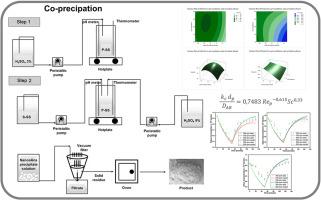利用易溶共沉淀法从地热二氧化硅中高效合成二氧化硅纳米颗粒:统计优化和动力学分析
IF 4.3
2区 材料科学
Q2 ENGINEERING, CHEMICAL
引用次数: 0
摘要
二氧化硅纳米颗粒在农业、制药、生物医药、陶瓷和先进材料等一系列行业中发挥着至关重要的作用。然而,传统的合成方法通常依赖于昂贵且对环境不利的化学前体。本研究探讨了地热发电厂的副产品地热污泥可以作为一种可持续和高效的来源,通过简化的合成方法来生产高纯度的二氧化硅纳米颗粒。该工艺包括三个关键的净化阶段:水洗、酸浸和转化为硅酸钠,然后共沉淀法得到最终的二氧化硅产品。为了优化合成工艺,采用响应面法对实验条件进行了统计评价,以确定pH和水玻璃配比对二氧化硅收率的影响。在中性pH条件下,水玻璃体积比为1:1,收率为100%,纯度为97.03%。利用元素分析、x射线衍射和电子显微镜对材料进行了表征,以确定材料的结构和形态特性。此外,动力学模型揭示了搅拌速度和温度对二氧化硅沉淀动力学的影响,并建立了无因次关联关系来量化过程中的传质系数。这一发现为利用工业废料作为原料生产二氧化硅纳米颗粒提供了一条更有前途和更可持续的途径。虽然没有评估直接的财务指标,但利用现成的副产品和简化的工艺条件表明可能具有经济优势,值得在今后的工作中进一步进行技术经济评价。本文章由计算机程序翻译,如有差异,请以英文原文为准。

High-yield synthesis of silica nanoparticles from geothermal silica via a facile co-precipitation method: Statistical optimization and kinetic analysis
Silica nanoparticles play a vital role in a range of industries, including agriculture, pharmaceuticals, biomedicine, ceramics, and advanced materials. However, conventional synthesis methods typically rely on expensive and environmentally burdensome chemical precursors. This study explores the hypothesis that geothermal sludge, a by-product of geothermal power plants, can serve as a sustainable and efficient source for producing high-purity silica nanoparticles through a simplified synthesis approach. The process involves three key purification stages—water washing, acid leaching, and conversion to sodium silicate—followed by co-precipitation to obtain the final silica product. To optimize the synthesis, experimental conditions were statistically evaluated using response surface methodology to identify the effect of pH and sodium silicate ratio on the silica yield. The highest yield (100 %) and purity (97.03 %) were achieved under neutral pH conditions and a sodium silicate ratio of 1:1 by volume. Material characterization was conducted using elemental analysis, X-ray diffraction, and electron microscopy to confirm the structural and morphological properties. In addition, kinetic modeling revealed the influence of agitation speed and temperature on silica precipitation dynamics, and a dimensionless correlation was developed to quantify the mass transfer coefficient during the process. The findings demonstrate a promising and more sustainable pathway for silica nanoparticle production using industrial waste as feedstock. While direct financial metrics were not assessed, the use of readily available by-products and simplified process conditions suggest potential for economic advantages, meriting further techno-economic evaluation in future work.
求助全文
通过发布文献求助,成功后即可免费获取论文全文。
去求助
来源期刊

Particuology
工程技术-材料科学:综合
CiteScore
6.70
自引率
2.90%
发文量
1730
审稿时长
32 days
期刊介绍:
The word ‘particuology’ was coined to parallel the discipline for the science and technology of particles.
Particuology is an interdisciplinary journal that publishes frontier research articles and critical reviews on the discovery, formulation and engineering of particulate materials, processes and systems. It especially welcomes contributions utilising advanced theoretical, modelling and measurement methods to enable the discovery and creation of new particulate materials, and the manufacturing of functional particulate-based products, such as sensors.
Papers are handled by Thematic Editors who oversee contributions from specific subject fields. These fields are classified into: Particle Synthesis and Modification; Particle Characterization and Measurement; Granular Systems and Bulk Solids Technology; Fluidization and Particle-Fluid Systems; Aerosols; and Applications of Particle Technology.
Key topics concerning the creation and processing of particulates include:
-Modelling and simulation of particle formation, collective behaviour of particles and systems for particle production over a broad spectrum of length scales
-Mining of experimental data for particle synthesis and surface properties to facilitate the creation of new materials and processes
-Particle design and preparation including controlled response and sensing functionalities in formation, delivery systems and biological systems, etc.
-Experimental and computational methods for visualization and analysis of particulate system.
These topics are broadly relevant to the production of materials, pharmaceuticals and food, and to the conversion of energy resources to fuels and protection of the environment.
 求助内容:
求助内容: 应助结果提醒方式:
应助结果提醒方式:


